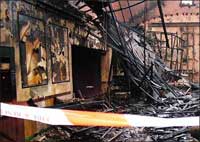Fire Restoration Tampa
Fire Restoration Services Tampa
Understanding the effects of a fire:
 The following information is provided to help owners evaluate the damage to their home or business caused by smoke and fire. This type of damage, through clean-up, deodorization and with knowledge, we are able to minimize the costly repairs caused by it. Here we will try to help you understand fire and smoke damage, and the residue and unseen odors that accompany them. We invite you to discuss any information on our site with restoration professionals, because this would ensure your home, business and furnishings is being correctly restored to pre-loss condition, or better. Moreover, by working with Restoration Experts you can increase your knowledge base.
The following information is provided to help owners evaluate the damage to their home or business caused by smoke and fire. This type of damage, through clean-up, deodorization and with knowledge, we are able to minimize the costly repairs caused by it. Here we will try to help you understand fire and smoke damage, and the residue and unseen odors that accompany them. We invite you to discuss any information on our site with restoration professionals, because this would ensure your home, business and furnishings is being correctly restored to pre-loss condition, or better. Moreover, by working with Restoration Experts you can increase your knowledge base.
A Professional Restoration Company is always conscious of time in a fire loss, as they understand that just because the fire is out, does not mean the damage has stopped. They know that the longer corrosion control and emergency cleaning is delayed, the greater the costs increase on the loss.
Fire Restoration Tampa
Certified professionals have the experience and training to work with the home and business owners. In this professional courtesy they will work with the insurance company’s, (if available), and the home/business owners. Then coordinate the efforts that will return the structure and contents back to pre-loss condition, or better, by choosing the best avenue in restoration techniques.
A fire loss is not just the physical destruction of combustible materials, but there are those unseen damages that are the side effects of this type of damage.
Lets say for instance you did not have a physical fire in your home, but instead you put a Turkey or some other meat on the slow burner and went out for a while. For some reason you forgot to turn it off, or did not make it back, or some malfunction happened and the meat was burned to a pile of disfigured black coal looking clump, but without actually catching anything on fire. It is unknown if these types of fires actually catch on fire as there are usually no witness’ to the event. You do not see anything, but there is this foul odor in the air. You air out your house, and even spray deodorizers for weeks, and that burnt odor just won’t go away.
Let’s take a look at this type of loss, first the slow carbonization of most any meat on the stovetop or in an oven, is called a “Protein Fire”. They usually reduce the meat into ashes or charred bone, and occasionally destroy the pot or pan it was being cooked in. The protein particles are released into the air and attach to most any surface, this residue is unseen in most cases, and is sometimes oily to the touch. It will invade cracks in walls, attach itself in carpeting, furniture, and most any porous surface, not to mention in most cases it will venture into the return vent of the HVAC system. When it gets into the ventilation system, it spreads throughout the entire structure, and as you can see where this is going, it can infect the entire structure with this foul odor.
Cleaning such problems involve special training and equipment, as time will not remove the odor in all cases. Because it involves an oily substance that attaches to almost all surfaces, dirt can be attracted to it, and compound the problem. It is important that the damage is cleaned properly and promptly, by cleaning all effected surfaces and having the HVAC system professionally cleaned.
Taking a look at the science of fire, how a fire actually starts, burns, and at the microscopic level, will help us understand the fundamental information necessary to better understand the fire restoration process.
As we all know fire has been with us since before the beginning of recorded history. Fire causes the transformation of matter into energy, and ash and carbon monoxide will result. It is these physical characteristics of fire that cause most of the problems in a loss, as this transformation of matter into something that causes secondary damage to a structure at the microscopic level.
Fire cannot start without some source of ignition, this ignition must provide sufficient heat to maintain the fire process. Almost anything can be the source of this ignition; gas, match, cigarette, electricity, candle, heaters even the sun reflecting through a piece of glass can cause the necessary ignition needed to start and maintain a fire.
These forms of ignition as well as any form of ignition cannot result without the correct heat range for the material to catch on fire. For example, paper will burn at a lower temperature than lets say wood. Almost any material on earth will burn or melt given the right temperature, as well as some gasses are more volatile than others.
Once you have the right temperature for the material in question, you have ignition. This is the beginning to the decomposition process that is caused by the process of fire, also known as “Pyrolysis” (transformation of a substance produced by the action of heat).
Pyrolysis is a chemical change -in a material brought about by heat, enough heat the fire results in either flaming combustion or smoldering combustion, that cause by-products of gases which begin to come out or vaporize. The gases will generally be both flammable-combustible (methane, hydrogen) and, or non-flammable (carbon dioxide, carbon monoxide, water vapor, etc.)
The non-flammable gases venture throughout the structure or general environment, and the flammable gases usually are hot enough to combust as soon as they mix or combine with oxygen in the air showing the actual presence of a flame, or flaming combustion. In addition, the flame cannot be seen in smoldering combustion, but instead a red-hot glowing is seen on the surface.
When these types of fires get going well, they are sure to cause; smoke and soot, tars or tarry residue, burned gases and heat. Moreover, the heat coming out of the flame and combustion process is hot enough to keep the burning material at or above its decomposition temperature, and will continue until it runs out of fuel, or a means to extinguish the flame is attained.
Depending on the fuel involved, and the amount involved in a fire, and the heat, will determine the resulting by-products caused by the pyrolysis process. Knowing this, and that there are several materials that cause different effects, for example: (liquids such as; gasoline, kerosene, alcohol, paint, oil, etc… – or solid materials such as; paper, wood, plastic, nylon carpeting, cotton, etc..). In addition, each will produce a completely different result, helping the restoration professional determine the different cleaning methods and cleaning solutions that will help with the restoration and clean up efforts. For example, when wood alone burns, the chemical by-products of decomposition are so complex that it is estimated there are over 1000, separate chemical compounds that can be identified from its burning, and this does not include near the materials involved in an average building composition today.
These gasses, smoke and soot, tars or tarry residue, can venture into the HVAC system of a structure. This will causes what is called a “puff-back”, which results in these gasses, smoke, soot, tars or tarry residue, to spread through the entire building should the system fan be running during the fire. This will result in the contamination of the HVAC system severely, not to mention other areas of the structure that was not in direct contact or closed off from the fire. In addition, soot can collect on previously unseen spider webs causing “soot webs” or “smoke webs”, that are sometimes seen after a fire, even in rooms on the opposite side of the building where the fire occurred.
With the known characteristics of air current in a building, we can expect smoke to migrate toward outside walls and windows, and consequently deposit residue more heavily there. With insulated walls, the window will provide a substantial temperature difference, and the circulation of currents may concentrate in that area. This is the reason a far heavier deposit of smoke or soot residue may be found on the back or lined portion of the drapery rather than on the surface that faces the room.
Now that we have learned how a fire starts, and what happens during the fire, lets take a look at what happens when the fire is extinguished. There are several ways a fire is extinguished, the best by far is by starving the fire of oxygen, but this is hard to do in a building unless you can afford a Halon fire extinguisher system. I would caution the use of as these systems as they will deprive an area of oxygen, resulting in the suffocation of anyone in the area.
With the many methods of extinguishing a fire; Freon type gaseous fire extinguishers, water, and foam extinguishers, they all have the same method in mind, smother and cool the fire and fuel. Each of these methods extinguishing will require different methods used in the restoration process. As the freon and foam fire extinguishers leave a mess that invades those cracks and crevasses, and of course water, which it the most common will mix with the ash and soot to form an acid that will cause further damage to anything it contacts.
The presence of water and steam in a fire, deposit as acids and acidic smoke-soot, and there so many fire decompositions that are acidic in nature, either from organic or inorganic acids. Sometimes we wonder which does more property damage-the fire or the water?
All these factors contribute to acid damage and deterioration of the contents and materials in a fire. In some cases, the acids may be strong enough to corrode metals, metal fixtures and even etch glass and chrome. Chemical and corrosion damage is another major source of damage, and the cost of losses from acid corrosion can be enormous.
The measurement of the success rate of the practical restoration experience, as well as business success is clearly evident through the restoration technique, though the underlying science of it is not. By contrast, however, the scientific measurements of the actual fire process are many and quite sophisticated.
We all should be knowledgeable in the basics of fire and fire risk, including some of the most important issues and means of fire prevention. Let’s face it, knowledge is power, and preventing fires saves lives as well as property. Be sure to follow up on fire prevention and test your smoke detectors regularly, as it is reported that most fires with smoke detectors installed were not operational, and only a small number of fires are buildings without smoke detectors at all.
In addition, you may want to look into flame-retardants. With all the ways that these fire retardants can be used, some treatments use chemicals that are absorbed by the fibers or fixed somehow on the material. Still other treatments are applied to the back coating in mattresses or upholstery or the backing as carpet latex. Still other fire retardants are formulated into shampoo or detergents, leaving some protective residue after the cleaning process.
